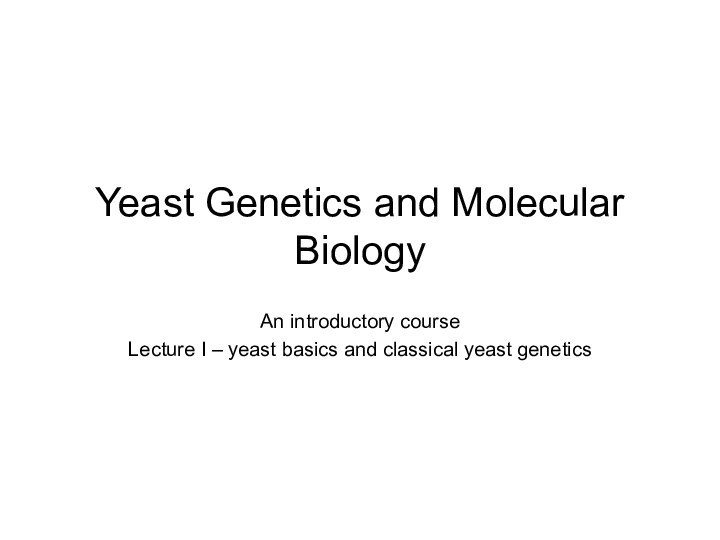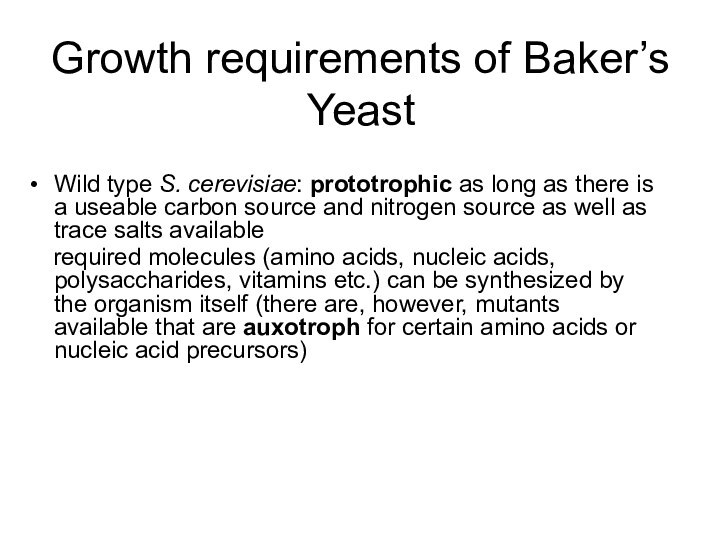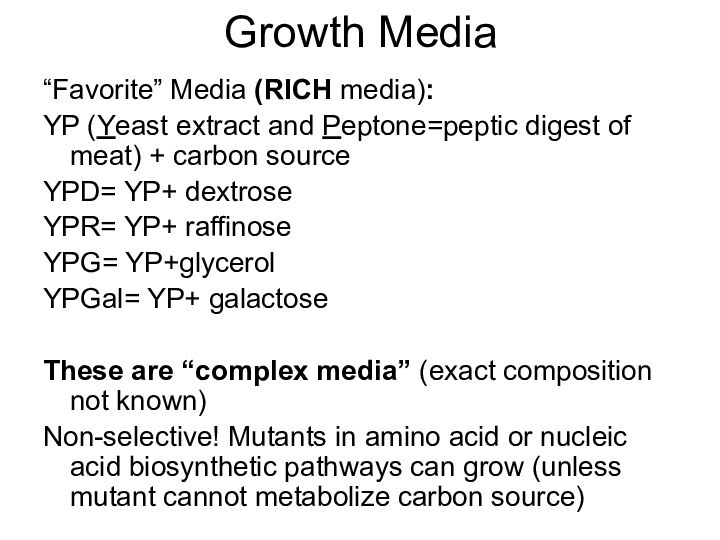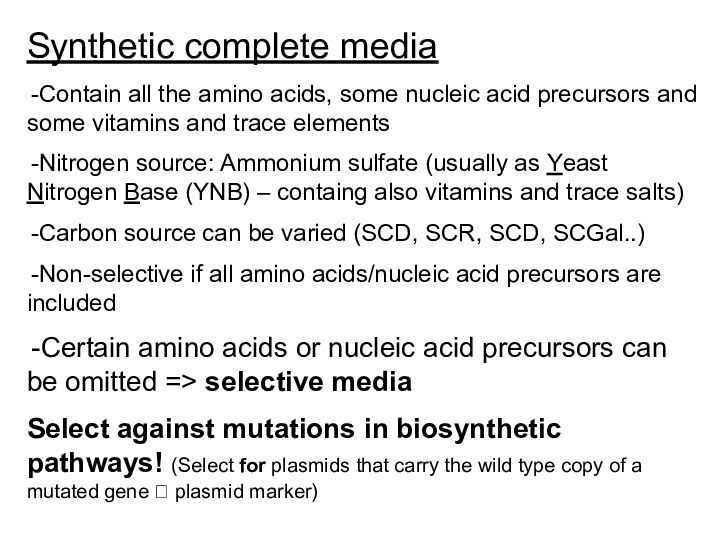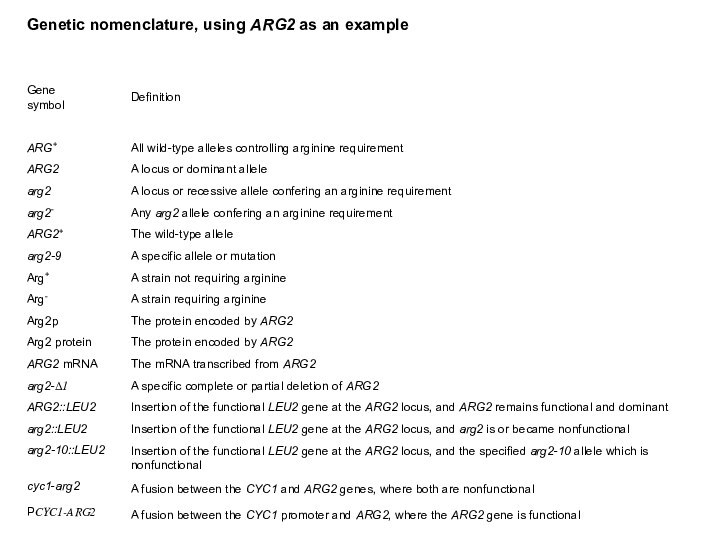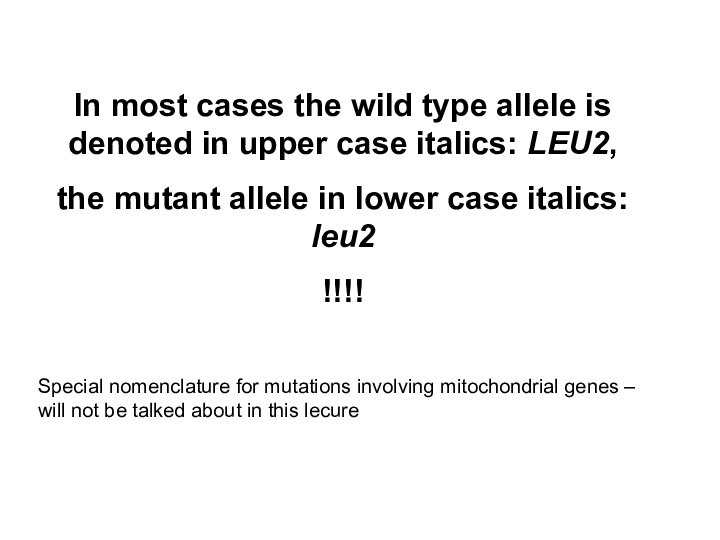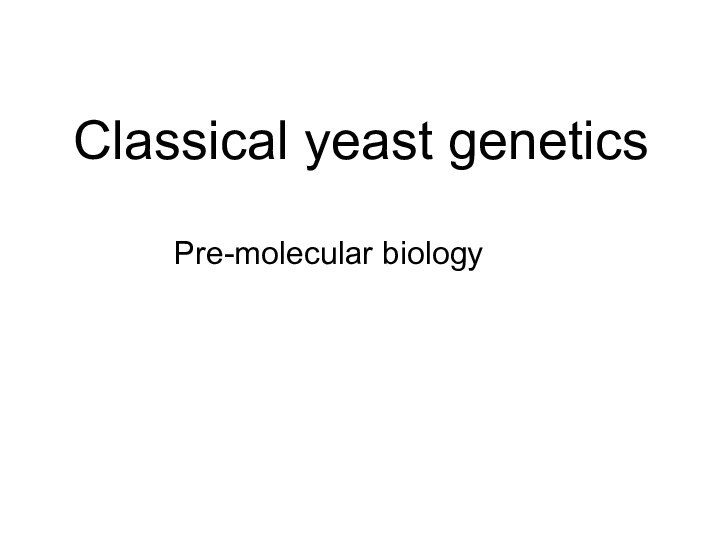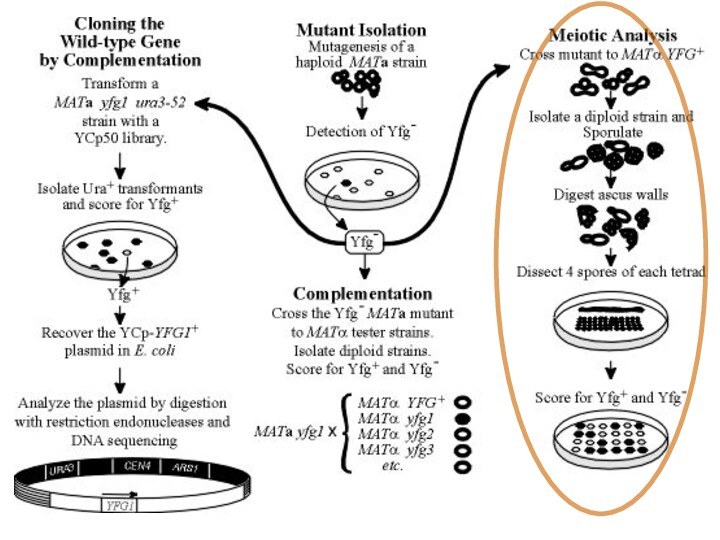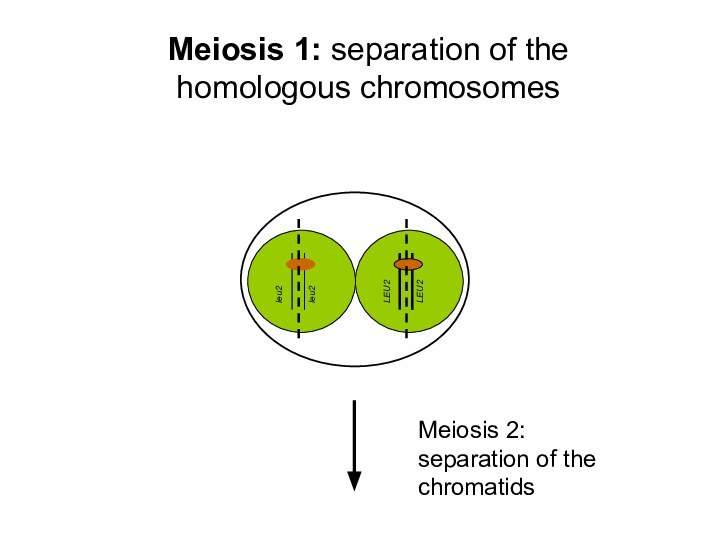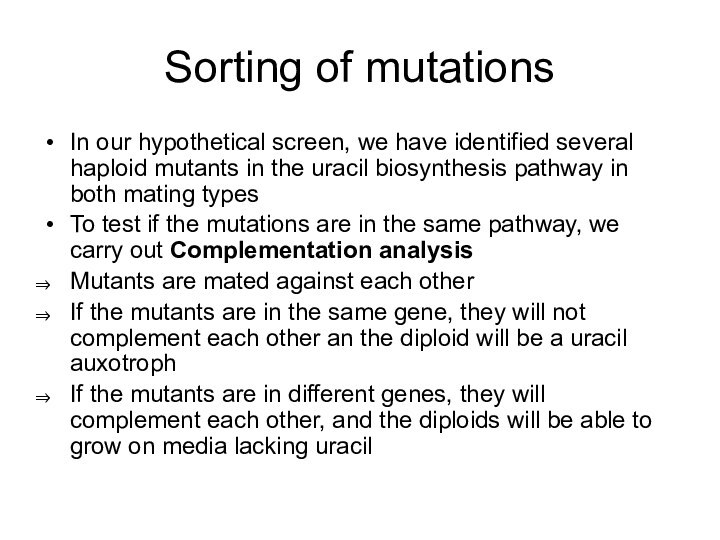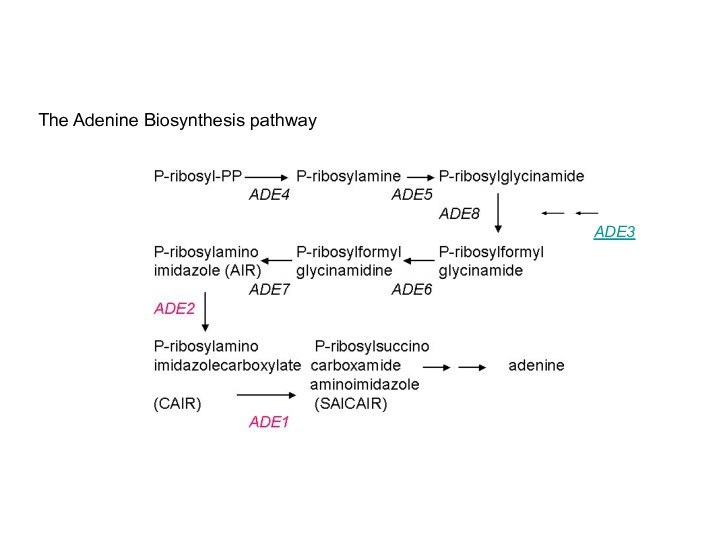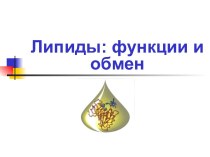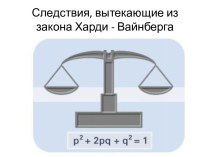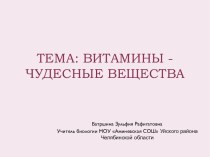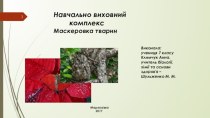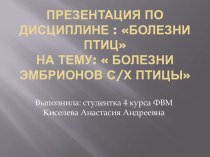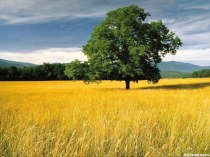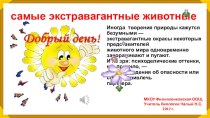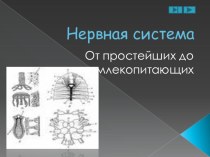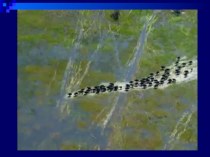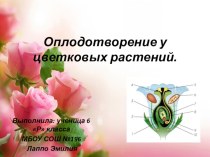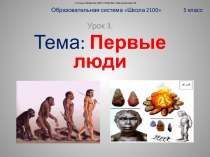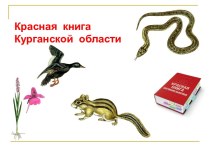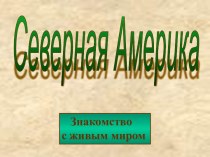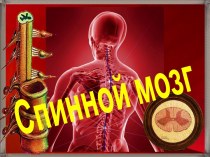Слайд 2
What is Yeast Genetics?
Definition of Genetics in Wikipedia:
“Genetics (from Ancient Greek γενετικός genetikos, “genitive” and that
from γένεσις genesis, “origin”), a discipline of biology, is the science of heredity and variation in living organisms”
Classical yeast genetics:
Desireable traits of naturally occuring yeast strain variants were combined by mating of the strains to generate hybrids and selection of offspring carrying combinations of these traits
Modern yeast genetics:
the cells are manipulated to generate mutants in pathways and processes of interest (generation of heritable variation)
Mutants with interesting phenotypes are selected or screened for and subsequently analyzed with molecular biology and biochemical methods to determine their function in the cell
Слайд 3
This slide was nicked from internet lecture notes
of a course held at the Universität München (Prof.
Horst Feldman)
http://biochemie.web.med.uni-muenchen.de/Yeast_Biol/
Слайд 4
Pioneers of yeast genetics
Øjvind Winge (1886-1964), Carlsberg laboratory,
Kopenhagen: http://www.genetics.org/cgi/content/full/158/1/1
Discovery of alternation of Haplo
– and Diplophase in Saccharomyces sp. –”Yeast Sex”; development of mechanical yeast manipulation and dissection methods
Carl C. Lindegren (1896-1987), Washington University, St. Louis; University of Southern Illinois, Carbondale, USA Isolation of heterothallic yeast strains (= mutant strains with a stable haploid growth phase)
Boris Ephrussi (1901-1979), Institutes Pasteur, Paris; Centre national de la recherche scientifique, Gif-sur-Yvette, France
Cytoplasmic inheritance (= mitochondrial genetics)
Слайд 5
Baker’s Yeast
Saccharomyces cerevisiae:
- Also “Budding yeast”
- Ascomycete (ascus
as fruiting body)
- Oldest domesticated organism?
Used in brewing
and baking for millennia
Favorite organism for molecular biologists
First eukaryotic genome to be sequenced in its entirety (1996)!
Yeast is a molecular biology model organism
http://biochemie.web.med.uni-muenchen.de/Yeast_Biol/
Yeast ascus with spore tertad
Source: wikimedia
Слайд 6
Requirements for Model Organisms:
Слайд 7
Yeast similarity to human cells
Слайд 8
Yeast as a Model Organism David Botstein, Steven A.
Chervitz, and J. Michael Cherry Science 1997 August 29; 277:
1259-1260. (in Perspectives)
Слайд 9
“Bacterial” aspects of yeast:
Single cell organism
Haploid growth phase
-> phenotype of recessive mutations shows up in the
first mutant generation
Fast growing (doubling every 1.5 hours on rich media)
Moderate growth media requirements
Transformation, gene replacement “easy”
Слайд 10
Processes that can be studied in yeast
Cell cycle
(mitosis, meiosis)
(Principles of) gene regulation
Metabolic processes
Cell-to-cell signaling
Cell specialization
Cytoskeletal organization
Intracellular
transport mechanisms
Compartmentalization
Mechanisms of retroviral activity
Слайд 11
Growth requirements of Baker’s Yeast
Wild type S. cerevisiae:
prototrophic as long as there is a useable carbon
source and nitrogen source as well as trace salts available
required molecules (amino acids, nucleic acids, polysaccharides, vitamins etc.) can be synthesized by the organism itself (there are, however, mutants available that are auxotroph for certain amino acids or nucleic acid precursors)
Слайд 12
Crabtree effect and oxygen requirements of S. cerevisiae
Preferred
carbon source: glucose, but many other carbon sources can
be used
If the carbon source allows, S.cerevisiae prefers to generate energy mainly by alcoholic fermentation
When glucose is in abundance, baker’s yeast turns off all other pathways utilizing other carbon sources and grows solely by fermenting glucose to ethanol (“Crabtree effect”)
S. cerevisiae is a facultative anaerobe: can grow by fermentation in the complete absence of oxygen, as long as the growth media is substituted with sterols and unsaturated fatty acids
On non-fermentable carbon sources energy generated solely by respiration, and oxygen in the environment becomes essential (required for survival)
Слайд 13
Examples of Fermentable and Non-Fermentable Carbon Sources
Слайд 14
Diauxic shift
Yeast prefers alcoholic fermentation if the carbon
source allows for it, until the fermentable carbon source
is exhausted
When there is no more fermentable carbon source in the media, the metabolism switches from fermentative to respiratory
This process requires the upregulation of genes involved in respiratory breakdown of ethanol, downregulation of genes involved in fermentation
Growth slows down after the diauxic shift
Time (hrs)
OD600= optical density at the wavelength of 600 nm;
Not Absorbance!; only linear between 0.3 and 0.7
The corresponding cell count differs from strain to strain (cell size!)
Слайд 15
Growth Media
“Favorite” Media (RICH media):
YP (Yeast extract and
Peptone=peptic digest of meat) + carbon source
YPD= YP+ dextrose
YPR=
YP+ raffinose
YPG= YP+glycerol
YPGal= YP+ galactose
These are “complex media” (exact composition not known)
Non-selective! Mutants in amino acid or nucleic acid biosynthetic pathways can grow (unless mutant cannot metabolize carbon source)
Слайд 16
Synthetic complete media
Contain all the amino acids, some
nucleic acid precursors and some vitamins and trace elements
Nitrogen
source: Ammonium sulfate (usually as Yeast Nitrogen Base (YNB) – containg also vitamins and trace salts)
Carbon source can be varied (SCD, SCR, SCD, SCGal..)
Non-selective if all amino acids/nucleic acid precursors are included
Certain amino acids or nucleic acid precursors can be omitted => selective media
Select against mutations in biosynthetic pathways! (Select for plasmids that carry the wild type copy of a mutated gene ? plasmid marker)
Слайд 17
Minimal media
Carbon source and Nitrogen source (YNB)
Only wild
type yeast can grow
Слайд 18
Yeast Gene and Gene Product Nomenclature
Dominant alleles are
written in italicised capital letters: LEU2, ADE3, ARG2
Attn:The number
of the gene does not necessarily denote the place of the gene in a metabolic pathway. The numbering is often historical due to the order in which mutant alleles of the gene were obtained
Recessive alleles are written in italicised lower case letters: leu2, ade3, arg2
Sometimes mutant allele variants are indicated with a dash and an additional number: leu2-1, leu2-3….
Dominant gene products (=proteins) are written in regular letters, with the first letter capitalized: Leu2, sometimes followed by a lower case p: Leu2p
Recessive gene products are written in lower case: leu2 (leu2p)
Слайд 20
In most cases the wild type allele is
denoted in upper case italics: LEU2,
the mutant allele
in lower case italics: leu2
!!!!
Special nomenclature for mutations involving mitochondrial genes – will not be talked about in this lecure
Слайд 21
Classical yeast genetics
Pre-molecular biology
Слайд 23
The Life Cycle of Saccharomyces cerevisiae
Wild type strains
Most
laboratory strains (ho-)
2n
1n
2n
1n
Starvation
(no sugar,
no NH4+)
Слайд 24
Yeast has a haploid growth phase
Phenotype of
mutation apparent immediately
Every haploid strain is a “pure bred”
strain for its genetic traits
Haploids are “Gametes”
Sporulation = Meiosis; products of the same meiotic event can be examined!
Слайд 25
Genetic Manipulation
Ability to mate yeast cells allows combining
of mutations
Meiotic products (spores) are packed in a
spore sac (Ascus) and can be physically separated -> dissection of spores allows for dissection of pathways
Слайд 26
Genetic analysis of a simple mutation
“Wild type” strain
(Leu+)
“mate”
Слайд 27
Segregation of two alleles involved in Leucine biosynthesis
Cells are Leu+, as the functional copy of LEU2
is sufficient to support growth on media lacking the amino acid Leucine
Sporulate on acetate medium
(Meiosis)
Diploid = Zygote
Слайд 28
Meiosis 1: separation of the homologous chromosomes
Meiosis 2:
separation of the chromatids
Слайд 29
Digest off cell wall
Tetrad with 3 spores visible
in one focal plane and 4th spore visible in
a second focal plane
4 spores of a tetrad
Dissect ascospores!
Spores = Gametes!
Ascus = spore sac
Слайд 31
Line up on grid
Non-selective media (e.g. YPD)
Selective media
(SC- Leu)
Leu-
Leu-
Слайд 32
Original Dissection on Non-selective plate
Replica on selective plate
(e.g. Leu- strain on SC – Leucine)
2 : 2
segregation ratio
(Leu+ vs. Leu- spores)
Слайд 33
Segregation of two unlinked genes
Example: TRP1, LEU2
Haploid, Leu+,
Trp-
Haploid, Leu-, Trp+
Diploid, Trp+, Leu+,
Слайд 34
Possible distribution of chromosomes during meiosis
Resulting tetrads after
sporulation
parental ditype
(Trp+, Leu- : Leu+,Trp-)
TRP1
TRP1
nonparental ditype
(Trp+, Leu+
:Trp- Leu-)
Слайд 36
Ratios of different types of tetrads! (NOT spores)
Слайд 37
Distances between linked genes can be calculated by
counting the different tetrad types;
Formula:
½ T + NPD (recombinants)
Total
tetrads
Distance is expressed as recombination frequency in %
1% recombination = 1cM (centimorgan, after the famous fruit fly geneticist Thomas Hunt Morgan)
Recombination frequencies can never be > 50%
(= random assortment; genes behave unlinked)
X 100
Слайд 38
Dissecting Metabolic Pathways in Yeast
Question: What enzymes are
involved in the Biosynthesis of Uracil?
Approach: Screening for mutants
dependent on uracil in the growth media
Mutagenize a healthy yeast strain (UV light, alkylating agents)
Plate mutagenized cells on non-selective media
Replica plate onto synthetic media lacking uracil (SC – Ura)
Слайд 40
YPD
SC - Ura
Most colonies still wild type –
can grow on synthetic media lacking uracil, but a,
b and v are uracil auxotrophs – they have a new growth requirement (presence of uracil in the media) – and can’t grow on synthetic media lacking uracil
Слайд 41
Sorting of mutations
In our hypothetical screen, we have
identified several haploid mutants in the uracil biosynthesis pathway
in both mating types
To test if the mutations are in the same pathway, we carry out Complementation analysis
Mutants are mated against each other
If the mutants are in the same gene, they will not complement each other an the diploid will be a uracil auxotroph
If the mutants are in different genes, they will complement each other, and the diploids will be able to grow on media lacking uracil
Слайд 42
Complementation analysis Scenario 1: mutations are in the
same gene
Ura-
Ura-
Ura-
Diploid cannot grow on SC – ura =>
Mutant A (α) and mutant 1 (a) cannot complement each other and are therefore in the same complementation group
Conclusion: Mutant A (α) and mutant 1 (a) are in the same gene uraX; as there is no functional copy of uraX in the cells, they are uable to synthesize uracil;
Mutant A, α mating type
Mutant 1, a mating type
Diploid a/α
Слайд 43
Complementation analysis Scenario 2: mutations are in different
genes
Ura-
Ura-
Ura+
Mutant A, α mating type
Mutant 2, a mating type
The
diploid is able to grow on SC – ura => Mutant A (α) and mutant 1 (a) are able to complement each other and are in different complementation groups
Conclusion: Mutant A (α) and mutant 2 (a) are in different genes uraX and uraY; as there is one functional copy of each URAX and URAY in the cells, they are able to synthesize uracil;
Слайд 44
Complementation of mutants in the uracil biosynthesis pathway
(+)
= mutants complement each other ; (-) = mutants
do not complement each other
Complementation groups: 1. A,D, 1, 3, 4 2. B, 5, 6 3. C,E, 2
Mutants in the same complementation groups have mutations in the same gene
Слайд 45
Epistatic Analysis
Epistasis - the interaction between two or
more genes to control a single phenotype
Epistatic Analysis:
determine the order and/or relation ship of genes in a pathway
Слайд 46
Example of Epistatic analysis
Example: Adenine biosynthesis mutants ade2
and ade3 (unlinked genes):
ade2 mutants are Ade-, make red
colonies
ade3 mutants are Ade-, make white colonies
Double mutant will reveal position of genes/gene products in the adenine biosynthesis pathway relative to each other
Слайд 47
Scenario I
Scenario II
Two possibilities of order of action
of Ade2p and Ade3p in this pathway:
Слайд 48
ade2 mutant, α mating type
Ade -, RED
ade3 mutant,
a mating type
Ade-, creamy white
Diploid is white, Ade+
sporulate
Слайд 49
Possible distribution of chromosomes during meiosis
Parental Ditype -
uninformative
All Ade-
Слайд 50
Nonparental Ditype – informative (two spores carry both
mutations)
Two Scenarios
Слайд 51
2 x Ade+, white
Double mutant, Ade-, RED
A ------->
B (red pigment) ------> C ------> D …
The ADE2
gene product catalyzes a reaction upstream of the ADE3 gene product. A mutation of ade2 blocks adenine synthesis at a point where the intermediate is a red pigment
Scenario 1
Ade3p
Ade2p
Слайд 52
2 x Ade+, white
Double mutant 2x Ade-, WHITE
The
ADE3 gene product catalyzes a reaction upstream of the
ADE2 gene product. A mutation of ade3 blocks adenine synthesis at a point upstream of the formation of the red pigment. The cells are white.
Scenario 2
A -----> B ------> C ------> D (red pigment)---->…
Ade3p
Ade2p
Слайд 53
or
ade 3
ade3
ADE3
ADE 3
ADE2
ade 2
ade2
ADE 2
Tetratype
Слайд 54
Tetratype
Ade-, white
Ade+, white
Ade-, red
Ade-, white
Ade-, white
Scenario1
Scenario2
A -----> B
------> C ------> D (red pigment)---->…
Ade3p
Ade2p
A -------> B (red
pigment) ------> C ------> D …
Ade3p
Ade2p
